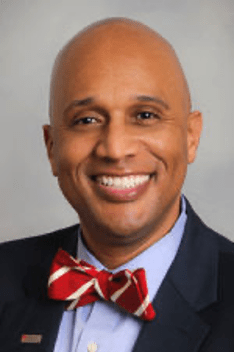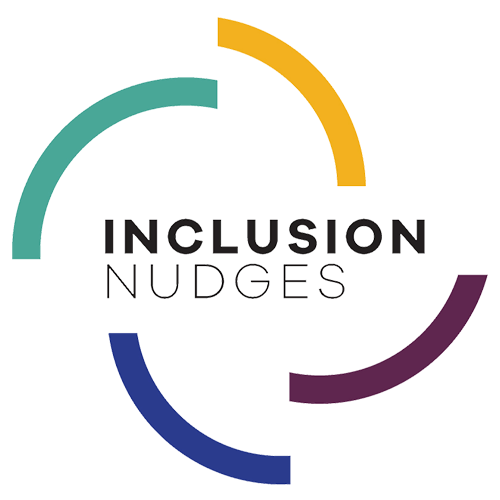‘Calling out’ inappropriate behaviour is a vividly recommended action to create change. It can have a big effect, but it matters a lot how this is done to achieve the desired effect. Unfortunately, too often, it’s executed as blaming and shaming. As such, it is a barrier. In this blog post we share with you another technique to avoid this. It’s about ‘calling in’ behaviours for creating change dialogues. In an interview with Dr. Robert L. Canida, Vice President for Inclusive Excellence in the Office of the President at University of Lynchburg, he shares with us how this approach engages people in personal dialogue for behavioural change.
’Calling out’ behaviours is when people make explicit statements about inappropriate, illegal, and/or discriminatory behaviours of other people – either directly to the person (in private) or in public (in the presence of others or on social media or media outlets).
It’s triggered by real experiences that happened to the accusers themselves or that they witnessed happening to others (allyship). Publicly ‘calling out’ is felt to be the most effective path to stop the behaviour, especially when people with low power are confronting high-status, powerful people and there is low or no trust in the system or organisation to fairly hear and address their complaints. Many movements of change (#MeToo or #BlackLivesMatter) have used this approach with positive impact.
As a change-maker, ‘calling out’ is a tool to consider. And it is also an approach to apply with caution.
Some ‘calling out’ backlashes
There can be a downside when ‘calling out’ is done with the intent of only shaming someone rather than seeking a change. ‘Calling out’ can backfire by deepening ‘us against them’, ideology entrenchment, a lack of understanding the ‘other’ person, and with no opening for apology or forgiveness. We miss out on achieving impactful behavioural and system changes.
This is amplified when ‘calling out’ on social media with its distance, anonymity, superficiality, snap reactions, and group dynamics.
‘Calling out’ harmful, inappropriate, discriminatory behaviours is fundamental to creating change especially by disenfranchised groups of people within an unjust system. We can’t change what we don’t see, and often we need others to point out what we may not notice in ourselves or our organisations. But when ‘calling out’ is done through online postings alone, it becomes like a ‘hit and run’ with no deeper engagement or dialogue for change.
Fear, embarrassment, shame, and resentment become the dominate emotional drivers in the ‘accused’ person. This is not to say that we should emotionally protect the ‘offender’ but it is to ensure that we have clarity on how, when, and why we use the ‘calling out’ change technique. If the purpose is merely to shame or punish, then we miss out on engaging them into dialogue and them becoming an ally. This is how ‘calling out’ can become a barrier to change.
Learn more about this hidden barrier in the long list of stuck patterns for achieving diversity, equity, and inclusion in The Inclusion Nudges Guidebook. We call the ‘blaming and shaming’ approach “Finger Pointing & Finger Wagging”. You can also find it in the Action Guide Inclusion Nudges for Motivating Allies.
‘Calling in’
In a recent conversation, Robert Canida shared with Lisa about the practice that he uses of ‘calling in’.
We (Tinna & Lisa) appreciate this change engagement and dialogue technique, and we’ve invited Robert to share more about it with us and you. Thank you, Robert for being willing to share your insights and experiences.
Practicing the ‘Calling In’ Approach:
An Interview with Dr. Robert L. Canida, II
Vice President for Inclusive Excellence Division of Inclusive Excellence-Office of the President University of Lynchburg, Virginia, USA

LISA: Hello Robert! Would you please share about yourself and your work?
ROBERT: “For 20 years, I have been a JEDI (Justice, Equity, Diversity, Inclusion) and Belonging Practitioner, speaking up for those who feel that they do not have a voice. Additionally, I see myself as what the great late US civil rights icon Bayard Rustin called an “Angelic Troublemaker”, one that questions everything!”
LISA: That’s a powerful mission! When we recently spoke, you shared with me about the practice of ‘calling in’ that you use in your JEDI and Belonging work. Could you please explain more about this? What is it? How is it different from ‘calling out’? Why would you use a ‘call in’ approach?
ROBERT: “‘Calling in’ is a concept that allows one to bring to the attention of the ‘offender’ to the negative impact of their words, actions, and/or behaviors. The key to being successful in having this difficult conversation is to approach it with respect and benevolence. Think about it in this perspective: “How might we call out the behavior, while calling in the person?”1. When you neglect to approach the conversation with kindness, you hinder the chance of reaching any understanding.
‘Calling out’ is a concept that presents the need for someone to address the ‘offender’ by letting them know how unacceptable their words and actions are, and will not be tolerated. Approaching a situation that is an ‘ouch’ moment and handled in a combative manner can easily end any productive conversation. In my experience, I have found ‘calling in’ to be more productive and valuable. ‘Calling in’ allows you to seek understanding by actively listening, learning different perspectives, and creating the opportunity for reflection.”
LISA: How have you used ‘calling in’ in your change-making work?
ROBERT: “During the 20 years doing this work, I’ve come in contact with a myriad of individuals who questioned the purpose of my work. However, there was one incident that vividly remains in my consciousness. I used to host a diversity film series and invited the entire campus community to attend. This particular film was called, “What the Bible Says About Homosexuality.” Although I was working in the US rural south at that time and knew the not so positive attitudes around LGBTQIA+, I was willing to open the proverbial pandora’s box. As a JEDI and Belonging practitioner, it’s my responsibility to challenge individuals to think differently and respect ‘others’.
So, I wrote the email and pressed the send button. Within minutes, I received an employee response stating, “Shame on you for trying to convert our students!” Shocked, quickly led to an attitude of “how dare they!”. My first instinct was to send a reply with, “Wow. I need to stop you right there!”2.
However, I sat for a moment and reflected on my original email, thinking that I indicated the film was about conversion or about recruitment. None of these things were true, so I decided to send the co-worker my response, asking them, “Help me understand your intention behind your email.” Surprisingly, they answered that this type of film is against their belief and did not have a place on campus. Once again, I was tempted to call this person out for not understanding the true meaning of diversity and inclusion. However, I replied with “thanks for sharing your perception”. Needless to say, this co-worker did not attend the showing. Nevertheless, I stayed true to my professional calling and learned a bit more about the organizational culture and my co-workers.”
LISA: Thanks for sharing that, Robert.
Here’s an example of when I (Lisa) recently used ‘calling in’ rather than publicly ‘calling out’. I noticed a job announcement for a DEI role in a US southern city. The job description sounded sincere for someone to lead DEI. However, in the information about the city where the organisation is located, there were words that glorified and romanticised the history of the city—what has been a white supremist, racist culture. I was really shocked.
I considered ways to respond and what I hoped would be the outcome. I wanted the decision-makers to understand how the language used is racist and excludes (in direct contradiction to what they stated they were seeking in the job description). I hoped that how I reached out to them would lead to reflection and noticing of other patterns. And in turn, lead to taking action, such as not using this language and applying designs to be more inclusive and equitable within their processes, like in the writing of job descriptions. To support this happening, I decided to privately approach (‘calling in’) the head of the search agency and also the head of HR in the hiring organisation about this unacceptable language and the implications. While neither responded back to me directly, they did receive my message which hopefully triggers a different course of action going forward. And it might be that going public through ‘calling out’ is a next step should this continue with other communications by this and other organisations about this city.
LISA: Robert, do you have another example of when you’ve used ‘calling in’, such as with leaders or people with high power? And did this lead to a new type of discussion with them and perhaps behaviour change?
ROBERT: When I think of the ideal role model that changes organizational behavior, a leader comes to mind. And whereas I think everyone has leadership qualities, in this context, I am referring to positional leadership—one that possesses a level of power and/or authority. About 15 years ago, I came in contact with such a leader who should have been called out for making a very demeaning comment to a student. As I was exiting the University’s administration building, I overheard a student complimenting a senior administrator on their jewelry. The response that I expected to hear was “thank you.” Instead, the administrator’s response was “If you get to my level, maybe you will be able to afford this.” The student walked away, looking rather deflated. I turned to that administrator and respectfully said, “Can I ask you a question? What was your intention for addressing the student in that manner?” The response was “What do you mean?”. The conversation ensued with me sharing my perception of the situation and how their response impacted the student. I said “Did you notice the student did not thank you or even replied, but walked away?”. In my mind, I thought, “Are you trying to get yourself fired?”. Much to my surprise, the administrator thanked me for bringing this to their attention. The intent behind their comment, at least through their eyes, was the hope that the student would be inspired to reach for the stars. Regardless of the intent, their delivery required me to ask for understanding by ‘calling in’, which resulted in the administrator to reflect.
LISA: Robert, any learnings to share that you had about this approach of ‘calling in’?
ROBERT: ‘Calling in’ is an approach that builds community and improves relationships. As a JEDI practitioner, I have responsibility to address acts of microaggressions, microinsults, or anything resulting in a person feeling excluded. I am inspired by Malala Yousafzai’s quote, “I raise my voice, not to shout, but so that those without a voice can be heard!”. I haven’t shied away from difficult conversations. I count my success in this work, from being patient, understanding, and open to honestly hearing perspectives different than mine. ‘Calling in’ is a method to do this.”
Thank you, Robert for sharing your insights and experiences with all of us. ‘Calling in’ is one of many approaches that change makers can use for increasing inclusion and equity.
![]()
Tinna & Lisa
Have you applied the approach of ‘calling in’? How did that work for you? We’re curious to hear about your experience. Please contact us at contact@inclusion-nudges.org.
References
- This question is inspired by the School Reform Initiative’s Pocket Guide to Probing Questions, schoolreforminitiative.org/download/pocket-guide-to-probing-questions
- This question is inspired by the Oregon Center for Educational Equity: What Did You Just Say? Responses to Racist Comments Collected from the Field, education.up.edu/_files/2018_interruptions.pdf







